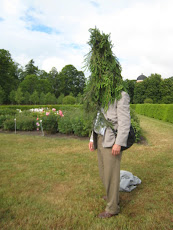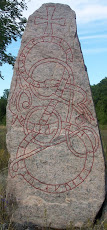What can we do and what can we not do?
What are we allowed to do, what are we not allowed to do?
What will arise from uncomfortable meetings and encounters?
How do we find and define friction in our daily life?
How can we use that friction in a constructive way?
The Festival curating is a part of the butoh choreographer SU-ENs pay back to the city of her origin. She is a rigorous nature. Nothing is left unattended. The intention and planning probably goes deeper than what we might expect from an ordinary artistic event. Friction II is also a follow up to the first Friction festival in 2006, and the planning started already there; all along the process the curator is improving, polishing, and exploring new possibilities opened up by success, or scandal.
The Friction II festival offered Live Art in Upsala city in a series of strange performance acts. Seniors citizens with Rollators were climbing the Castle Hill to the accompanying music of the Linné Quintet, Roi Vaara wrote and enacted on the pavement of the Castle Yard his work Spiral, the fakir Håvve Fjell in his work Floating hanged suspended over the Fyris river for two hours during the ordinary week end shopping, Delta RA'i offered his Feet Wash Ritual outside the Celsius Building at the mall of St Per, Malin Anrell made provocative acts of invisible theatre titled To Many Qustions entering situations of private citizens in the city area, Girilal Baars gave an out door/in door midnight musical performance Litanies in Zero Kelvin through the shining portal of the Chapel at the Old Cemetery, and Cecilia Germain, dressed up as a spruce, planted her Wild Seed in the Botanical Baroque Garden.
All these activities opened up for a more alert and immediate perception of our city. New aspects of places and restrictions, their richness and coerciveness, claimed their place in the consciousness of the audience. More questions were raised than will ever be answered, but the reflection over them is itself a creative activity. Here we might highlight a difference. People who just happened to be on the spot during one, or more performances probably have an all together different notion of the specific event, compared to those who attended the whole festival either as audience, or as part of the festival organisation. In the festival, the different acts were single Artworks, as well as building blocks in a sophisticated structure addressing philosophical and artistic issues concerning Performance Art. In this way the festival was interesting and relevant not only for the audience, but also for the artists and other stakeholders in the presence and future of Performance Art
Performance art was used as well, to explore the relations between institutions and individual artists, or art works, and further, between the art works and specific sites in the city kernel, or at the estate of the Ulva Old Mill.
Two main cultural institutions i Upsala were involved the City Theatre and the Art Museum. Together with the facilities of administrative, technical support, and arenas for the performances the institutions contributed with their different traditions and perceptions of performance art. There were clashes. For example when the aesthetic distance still prevailing in the Art Museum was challenged by the outright devotion to provocation, and the urge of theatrical performance to brake conventions, disregarding the mental disturbance it might cause. This was a fact when Malin Anrell in the announced Artist Talk was replaced by an arrogant boy (an actor) while the artist herself was lurking back stage. It was like the tool was taken directly from The Tool Box presented in the lecture by Danjel Andersson the same afternoon, but it wasn't. On the other hand, a conventional border line was perhaps unintentionally addressed in a subtle way when Arti Grabowski in the project room of the Art Museum attacked A Wall, while the audience was seated like in the theatre. Seen in this perspective Grabowski's performance became a comment to theatrical convention in a Visual Art setting. Interestingly enough, there is an art gallery at the city theatre; the Theatre Gallery. Here a video show was installed with five different works. Two live performances were presented here as well. It was the debutant work by Johanna Bodzek, Monastery of colours, where the artist played out with colours accompanied by the shaman music of Per Wedin, and it was The Seed, a work by the established performance artist Melati Suryodarmo based on black sesame seeds (who for mysterious reasons are hard to find in Western countries, while more common than the white seeds in the East). Video shows and two performance events were presented in the Project room of the Art Museum as well. Here Anna Berndtson presented her politically charged work Melt. Two elements of friction did occur during her act. Firstly, a conflict between the distanced aesthetic attitude of the audience and the urgent environmental message of the work, and secondly, the behaviour of the audience, framing itself as at the theatre, leaving chairs on the floor of the exhibition hall. The rest of the indoor performances took place in a regular theatre setting. It was the Fried Egg - Crazy Cabaret by Tine Louise Kortermand and Nina Björk Eliasson, which as the title suggests was well adapted to a scenic context. Further, Jenny Grönvall's A Briefing on Peggy Sue and Art was a faked lecture, and as such naturally addressed to a seated audience. Also in the video supported work 3/3 by Anders Rönnlund the seated audience was in its place. Finally it was comforting to see Seiji Shimoda executing his act On the Table in the same setting, now reminding of a circus. The scene comes natural to all these slightly different practices. In conclusion we might state the importance of institutional context and established practices for the possibility of discerning subtle qualities and friction between habits and news in art.
The feeling in public space of the city where Art met people in their every day lives was very different from the intimate atmosphere at Ulva Mill estate, where the audience attended the artworks due to their conscious choice. Only three works were presented at Ulva, the closing lunch uncounted. Melati Suryodarmo in the middle of the Fyris River made a two hours long Silent Trip, standing in the water with wings of red cloth suspended from trees on the shores, and wrapped around her body. Roi Vaara gave a fifteen minutes performance digging surrounded by singing birds in his work Showel, and Delta RA'i continued with his Feet Wash outside the mill. Finally, the closing of the Festival made us all participants in a blindfolded Concluding Lunch at Ulva Inn, where the distance of the glance was replaced by the intimacy of touch, as we were mutually finding ways to handle the challenges of this ordinary life situation, while deprived the sense of sight. In the city the Art clashed with non art events of different kinds. These clashes caused questions and comparisons concerning art versus commerce, traditional rituals, or the normal behaviour in public situations. At Ulva, on the other hand, the situation invited to make comparisons and search for cross references between the different artworks themselves at the actual site, or during the festival as a whole. The setting at Ulva was also dominated by the beauty of nature itself, which interacted in the most surprising ways with the performances in the perception of the works.


